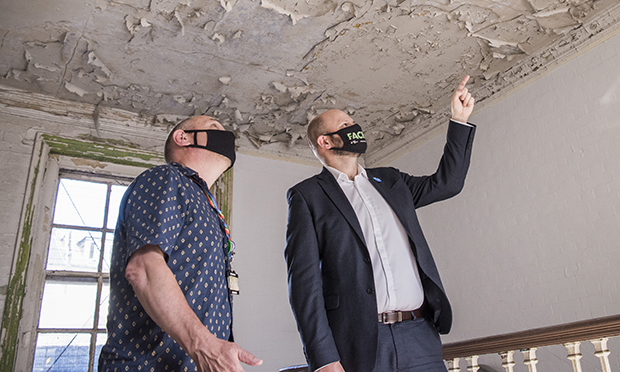Historic leisure centre in Lower Clapton set for roof repairs to ‘minimise health and safety risks’

Hackney Mayor Philip Glanville (right) at Kings Hall in 2021. Photograph: Hackney Council
An application has been made to repair parts of the roof at a historic Hackney leisure centre that first opened as a public bath house.
Hackney Council is asking for listed building consent to repair timbers and brickwork at 126-year-old Kings Hall on Lower Clapton Road.
The Grade II-listed building first opened in 1897 as a public baths with three swimming pools – first-class and second-class pools for men and a ladies’ pool.
At the time, many people did not have washing facilities at home.
Kings Hall is thought to be named after King Edward VII, who ascended to the throne in 1901.
The men’s first-class pool was covered over in the winter until the 1960s and used for entertainment such as indoor bowling and even a railway fair.
Attendance figures for 1971/72 show that the washing facilities were still in demand, with 60,000 visits to the warm baths and 15,000 to the showers, whilst the swimming pools were used 200,000 times.
It currently records 380,000 visits a year.
The men’s second-class pool and ladies’ pool were converted into a gym and sports hall in the 1990s.
According to a design and access report by conservation experts Alan Baxter, much of the timber roof is in a poor condition because of movement or water getting in.
The repairs include fitting new rafters and joists to match and support the existing ones. Roof coverings and tiles will be replaced like-for-like where needed.
The report said “repairs are necessary in order to prevent further damage or loss of fabric, minimise health and safety risks and to ensure the longevity of the listed building”.
Last year, the council approved a four-year contract worth £3.3m to a company to draw up designs for the refurbishment and prepare them to be submitted as a planning application.
According to English Heritage, “the baths retain numerous features of interest as well as a handsome frontage, and are listed as a building of special interest, embodying late Victorian civic concern for the promotion of cleanliness and fitness”.
